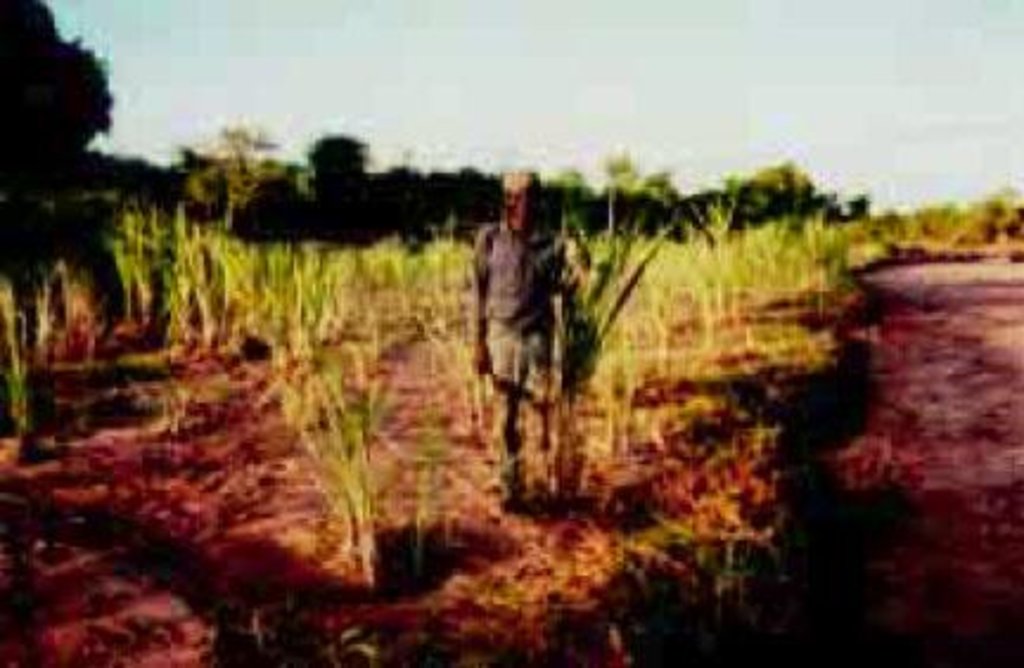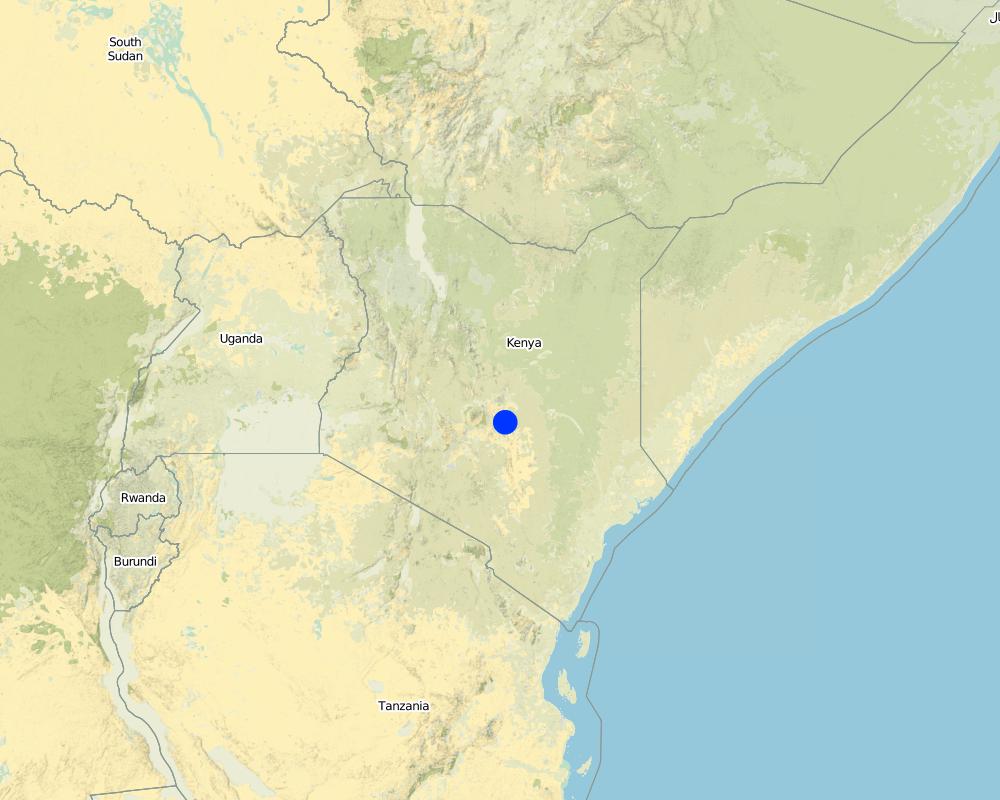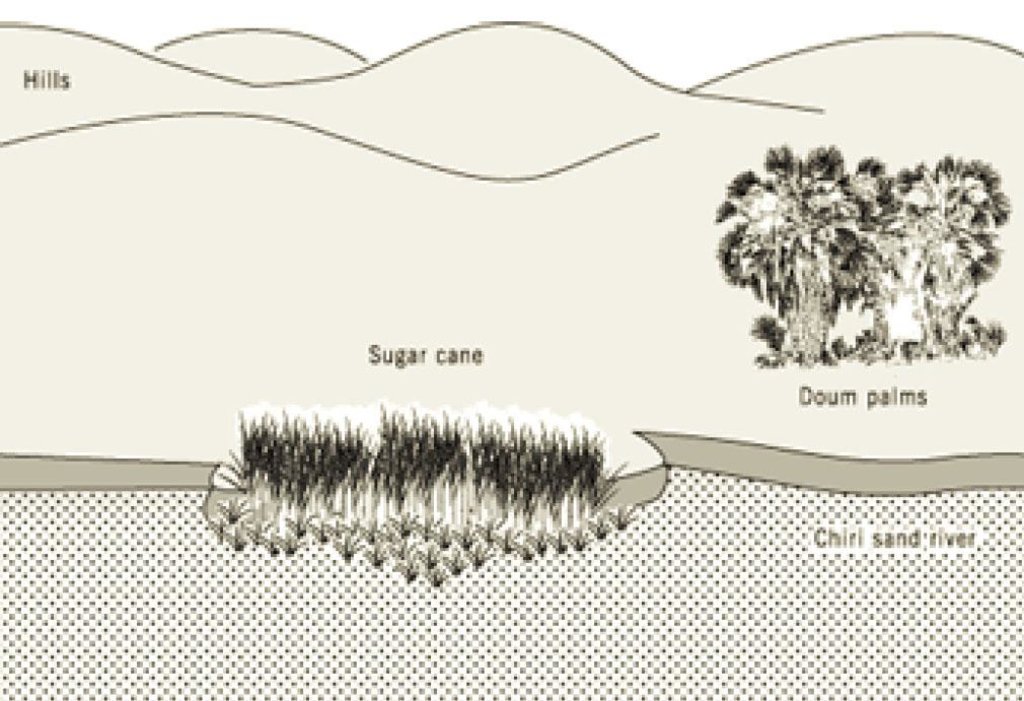Riverbed reclamation & silt trapping for sugarcane [Kenya]
- Création :
- Mise à jour :
- Compilateur : Kithinji Mutunga
- Rédacteur : –
- Examinateurs : David Streiff, Alexandra Gavilano
Kyanda (Kikamab)
technologies_1096 - Kenya
Voir les sections
Développer tout Réduire tout1. Informations générales
1.2 Coordonnées des personnes-ressources et des institutions impliquées dans l'évaluation et la documentation de la Technologie
Spécialiste GDT:
Ngati Mbuvi
MOARD
Kenya
Spécialiste GDT:
Mwendwa Linus
MOARD
Kenya
Nom du ou des institutions qui ont facilité la documentation/ l'évaluation de la Technologie (si pertinent)
Food and Agriculture Organization of the United Nations (FAO) - Italie1.3 Conditions relatives à l'utilisation par WOCAT des données documentées
Le compilateur et la(les) personne(s) ressource(s) acceptent les conditions relatives à l'utilisation par WOCAT des données documentées:
Oui
2. Description de la Technologie de GDT
2.1 Courte description de la Technologie
Définition de la Technologie:
Silt harvesting on riverbeds to maximise sugarcane growing in semi arid area
2.2 Description détaillée de la Technologie
Description:
The technology first involves fencing off part of a riverbed with cut thorn scrub in order to keep livestock away. The enclosed area is then mulched with brushwood and herbaceous materials in places. Sugar cane is planted and harvested piecemeal when mature. Kamuti plants a perennial grass (Cynodon dactylon) between the canes to help bind the sand. This exercise has been done, incrementally, over a series of seasons, enclosing an increasingly large area. When the rains return and the river flows, floodwater passes through and over the sugar cane and silt is deposited as the flow is slowed.
Purpose of the Technology: This initiative is categorized as an agronomic/vegetative measure, for reclamation of land. Its purpose is to increase water stored in the soil and to increase fertility by sediment harvesting, as a way of making land productive, while simultaneously addressing riverbed erosion. Farm income increase from the sale of sugar cane is the main production/ socio-economic benefit, while the ecological benefits include sediment accumulation, soil (ie riverbed and bank) loss reduction, soil cover improvement, increase in soil moisture and increase in soil fertility.
Establishment / maintenance activities and inputs: The action involves cutting tree branches, trimming pegs about 1m long, and hammering these pegs into the bed of the sand river, parallel to the bank, enclosing a long narrow strip. This initial strip may be 10 metres wide in a riverbed of 100 meters wide. The tree branches and trimmings are used to form a brushwood-netting barrier, which protects the area from livestock, and simultaneously slows the river flow and traps sediments. To further strengthen the barrier, star grass (Cynodon dactylon) is planted along the line of the fence. Inside the fenced-off area, sugar cane cuttings are buried at a depth of 0.4 m, and the same grass planted between the canes. The area is mulched with brushwood, which rots down to increase organic matter in the soil. These cuttings sprout and an intercrop of grass and sugar cane is the result. Maintenance comprises repairing the fence and cutting grass for mulching. No special tools are required. To be effective, the technology requires mulching every season, as the old mulch is covered by the silt load during the rainy period. The perimeter fence is maintained seasonally and requires considerable material. Occasionally when the rainfall is heavy, the sugar cane is swept away by floods and needs replacing.
Natural / human environment: The farm on which this technology is applied is in the arid far-north of Mwingi District. During the rainy season the farm can be inaccessible. The farmer, who is over 60 years of age, lives with his wives and children in what effectively forms a mini-village. The annual average rainfall in this area is barely 500 mm, and famine years are common. Temperatures are consistently high. The farm borders a dry sand riverbed.
2.3 Photos de la Technologie
2.5 Pays/ région/ lieux où la Technologie a été appliquée et qui sont couverts par cette évaluation
Pays:
Kenya
Région/ Etat/ Province:
Eastern Province
Spécifiez la diffusion de la Technologie:
- répartie uniformément sur une zone
Si la Technologie est uniformément répartie sur une zone, précisez la superficie couverte (en km2):
0,01
S'il n'existe pas d'informations exactes sur la superficie, indiquez les limites approximatives de la zone couverte:
- < 0,1 km2 (10 ha)
Commentaires:
Total area covered by the SLM Technology is 0.01 km2.
This technology is along a riverbed and it is not adapted by other farmers
Map
×2.6 Date de mise en œuvre de la Technologie
Si l'année précise est inconnue, indiquez la date approximative: :
- il y a plus de 50 ans (technologie traditionnelle)
2.7 Introduction de la Technologie
Spécifiez comment la Technologie a été introduite: :
- dans le cadre d'un système traditionnel (> 50 ans)
Commentaires (type de projet, etc.) :
Farmer own intiative
3. Classification de la Technologie de GDT
3.1 Principal(aux) objectif(s) de la Technologie
- améliorer la production
- réduire, prévenir, restaurer les terres dégradées
3.2 Type(s) actuel(s) d'utilisation des terres, là où la Technologie est appliquée

Terres cultivées
- Cultures pérennes (non ligneuses)
Cultures pérennes (non ligneuses) - Précisez les cultures:
- canne à sucre
- star grass (Cynodon dactylon)
Nombre de période de croissance par an: :
- 2
Précisez:
Longest growing period in days: 75 Longest growing period from month to month: Mar - May Second longest growing period in days: 60 Second longest growing period from month to month: Nov - Dec
Commentaires:
Main crop: star grass (Cynodon dactylon) and sugar cane
Major land use problems (compiler’s opinion): Extensive grazing of animals/unit area, uncontrolled felling and burning of tree in land preparation, low soil fertility due to continuous cultivation without conservation.
Major land use problems (land users’ perception): Low yields hence opening of large areas for cultivation. Difficult soils, hence ploughing during the rains. Infertile soils.
3.4 Approvisionnement en eau
Approvisionnement en eau des terres sur lesquelles est appliquée la Technologie:
- pluvial
3.5 Groupe de GDT auquel appartient la Technologie
- perturbation minimale du sol
- récupération/ collecte de l'eau
3.6 Mesures de GDT constituant la Technologie

pratiques agronomiques
- A7: Autres

pratiques végétales
- V2: Herbes et plantes herbacées pérennes

structures physiques
- S6: Murs, barrières, palissades, clôtures

modes de gestion
- M1: Changement du type d’utilisation des terres
Commentaires:
Main measures: agronomic measures, vegetative measures, management measures
Type of agronomic measures: mulching, zero tillage / no-till
3.7 Principaux types de dégradation des terres traités par la Technologie

érosion hydrique des sols
- Wg: ravinement/ érosion en ravines

dégradation chimique des sols
- Cn: baisse de la fertilité des sols et réduction du niveau de matière organique (non causée par l’érosion)
Commentaires:
Main type of degradation addressed: Wg: gully erosion / gullying
Secondary types of degradation addressed: Cn: fertility decline and reduced organic matter content
4. Spécifications techniques, activités, intrants et coûts de mise en œuvre
4.1 Dessin technique de la Technologie
Spécifications techniques (associées au dessin technique):
Reclaiming part of sand river bed with Sugar cane
Kenya
Technical knowledge required for field staff / advisors: moderate
Technical knowledge required for land users: high
Main technical functions: increase / maintain water stored in soil
Secondary technical functions: sediment retention / trapping, sediment harvesting, increase in soil fertility
Mulching
Material/ species: grasses
Quantity/ density: 2
Remarks: grass scattered
Grass species: stargrass
Change of land use type: fencing off portion of river bed
4.2 Informations générales sur le calcul des intrants et des coûts
autre/ monnaie nationale (précisez):
Kenya shilling
Indiquez le taux de change des USD en devise locale, le cas échéant (p.ex. 1 USD = 79.9 réal brésilien): 1 USD = :
70,0
Indiquez le coût salarial moyen de la main d'œuvre par jour:
1.50
4.3 Activités de mise en place/ d'établissement
| Activité | Calendrier des activités (saisonnier) | |
|---|---|---|
| 1. | fencing | after rains |
| 2. | mulching with bushes | before rains |
| 3. | planting of sugarcane | dry season |
| 4. | cuting grass for mulch | rainy season |
| 5. | fencing riverbed to keep off animals | after rain |
| 6. | planting grass | after rain |
4.4 Coûts et intrants nécessaires à la mise en place
Commentaires:
Duration of establishment phase: 24 month(s)
4.5 Activités d'entretien/ récurrentes
| Activité | Calendrier/ fréquence | |
|---|---|---|
| 1. | fencing | dry season / when height goes down |
| 2. | mulching with trash | dry '' / after clearing |
| 3. | grass planting | dry / before rains |
| 4. | sugarcane planting | wet / end of rain |
| 5. | collection of mulch | dry / biannual |
| 6. | fencing | after rain /biannual |
| 7. | cutting grass for mulch | rainy /biannual |
| 8. | scatterin thorn bushes | during rain /biannual |
| 9. | fencing | after rain / each cropping season |
| 10. | spreading brushwood | after / annual |
4.6 Coûts et intrants nécessaires aux activités d'entretien/ récurrentes (par an)
Commentaires:
Machinery/ tools: oxen plough, 2 pangas , 2 hoes
the above cost were calculated in terms of purchase of tools,material and manday used.
4.7 Facteurs les plus importants affectant les coûts
Décrivez les facteurs les plus importants affectant les coûts :
labour affects cost as it is required in large quantities
5. Environnement naturel et humain
5.1 Climat
Précipitations annuelles
- < 250 mm
- 251-500 mm
- 501-750 mm
- 751-1000 mm
- 1001-1500 mm
- 1501-2000 mm
- 2001-3000 mm
- 3001-4000 mm
- > 4000 mm
Zone agro-climatique
- semi-aride
- aride
5.2 Topographie
Pentes moyennes:
- plat (0-2 %)
- faible (3-5%)
- modéré (6-10%)
- onduleux (11-15%)
- vallonné (16-30%)
- raide (31-60%)
- très raide (>60%)
Reliefs:
- plateaux/ plaines
- crêtes
- flancs/ pentes de montagne
- flancs/ pentes de colline
- piémonts/ glacis (bas de pente)
- fonds de vallée/bas-fonds
Zones altitudinales:
- 0-100 m
- 101-500 m
- 501-1000 m
- 1001-1500 m
- 1501-2000 m
- 2001-2500 m
- 2501-3000 m
- 3001-4000 m
- > 4000 m
5.3 Sols
Profondeur moyenne du sol:
- très superficiel (0-20 cm)
- superficiel (21-50 cm)
- modérément profond (51-80 cm)
- profond (81-120 cm)
- très profond (>120 cm)
Matière organique de la couche arable:
- moyen (1-3%)
- faible (<1%)
Si disponible, joignez une description complète du sol ou précisez les informations disponibles, par ex., type de sol, pH/ acidité du sol, capacité d'échange cationique, azote, salinité, etc.
Topsoil organic matter: Becomes medium after the technology
Soil drainage / infiltration is medium - good
Soil water storage capacity is very low - medium
5.6 Caractéristiques des exploitants des terres appliquant la Technologie
Revenus hors exploitation:
- 10-50% de tous les revenus
Niveau relatif de richesse:
- pauvre
- moyen
Niveau de mécanisation:
- travail manuel
- traction animale
Indiquez toute autre caractéristique pertinente des exploitants des terres:
Population density: < 10 persons/km2
Annual population growth: 3% - 4%
5% of the land users are very rich and own 33% of the land.
10% of the land users are rich and own 25% of the land.
30% of the land users are average wealthy and own 12% of the land.
40% of the land users are poor and own 8% of the land.
15% of the land users are poor and own 21% of the land.
Off-farm income specification: most of harvest are low and hence dependent on off farm income.
Level of mechanization: Animal traction is used for assembling the thorny bushes and for marking farrows
5.8 Propriété foncière, droits d’utilisation des terres et de l'eau
Propriété foncière:
- communauté/ village
- individu, sans titre de propriété
Droits d’utilisation des terres:
- accès libre (non organisé)
- communautaire (organisé)
6. Impacts et conclusions
6.1 Impacts sur site que la Technologie a montrés
Impacts socio-économiques
Production
production agricole
Commentaires/ spécifiez:
Sugar cane
Revenus et coûts
revenus agricoles
Commentaires/ spécifiez:
Sugar cane
Impacts écologiques
Cycle de l'eau/ ruissellement
ruissellement de surface
Quantité avant la GDT:
60
Quantité après la GDT:
20
Sols
humidité du sol
couverture du sol
perte en sol
Quantité avant la GDT:
12
Quantité après la GDT:
5
cycle/ recharge des éléments nutritifs
6.4 Analyse coûts-bénéfices
Quels sont les bénéfices comparativement aux coûts de mise en place (du point de vue des exploitants des terres)?
Rentabilité à court terme:
légèrement positive
Rentabilité à long terme:
très positive
Quels sont les bénéfices comparativement aux coûts d'entretien récurrents (du point de vue des exploitants des terres)?
Rentabilité à court terme:
positive
Rentabilité à long terme:
très positive
6.5 Adoption de la Technologie
- 1-10%
Si disponible, quantifiez (nombre de ménages et/ou superficie couverte):
30 households (1% of the area stated)
De tous ceux qui ont adopté la Technologie, combien d'entre eux l'ont fait spontanément, à savoir sans recevoir aucune incitation matérielle, ou aucune rémunération? :
- 91-100%
Commentaires:
30 land user families have adopted the Technology without any external material support
Comments on spontaneous adoption: estimates
There is a moderate trend towards spontaneous adoption of the Technology
Comments on adoption trend: after farmer tour organised by the PFI most are attempting. At least five farmers had adopted the innovation by the beginning of 1999 (exact figures not available). This is a particularly site-specific system, and thus wide replication is simply not possible. It is only relevant to those who have farms bordering sand rivers with wide beds.
6.7 Points forts/ avantages/ possibilités de la Technologie
| Points forts/ avantages/ possibilités du point de vue du compilateur ou d'une autre personne ressource clé |
|---|
| This innovation demonstrates how productive use can be made of sub-surface moisture in sand rivers in arid areas while simultaneously protecting the riverbed and bank from erosion |
| Farm income increase through land reclamation |
6.8 Faiblesses/ inconvénients/ risques de la Technologie et moyens de les surmonter
| Faiblesses/ inconvénients/ risques du point de vue du compilateur ou d'une autre personne ressource clé | Comment peuvent-ils être surmontés? |
|---|---|
|
Planting within a riverbed is, strictly speaking, against regulations. |
Such technologies should not be attempted without consulting the local agricultural office. |
| The fence is constructed with thorn bush cuttings which have to be constantly replenished |
A live fence is recommended as an alternative to constantly having to replenish the fence with cut thorn bush. The fence is required to avoid grazing of the cane by domestic livestock. |
7. Références et liens
7.1 Méthodes/ sources d'information
7.2 Références des publications disponibles
Titre, auteur, année, ISBN:
Farm management Guidelines. 1989.
Disponible à partir d'où? Coût?
MOA, Nairobi
Titre, auteur, année, ISBN:
Kithinji M., Critchley W. 2001. Farmers' initiatives in land husbandry: Promising technologies for the drier areas of East Africa. RELMA Technical Report series no. 27
Liens et modules
Développer tout Réduire toutLiens
Aucun lien
Modules
Aucun module trouvé





